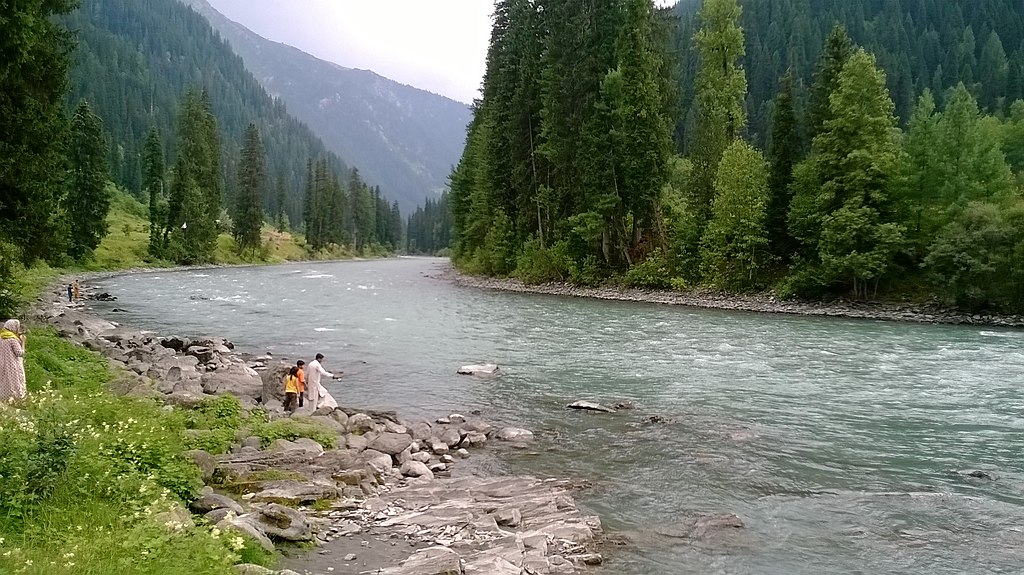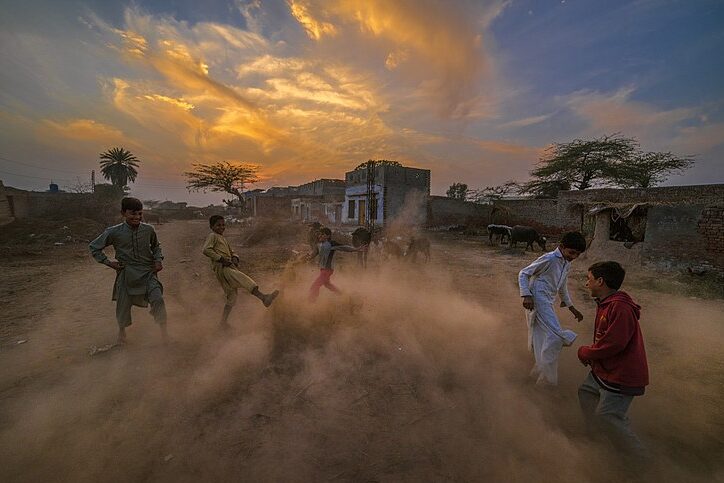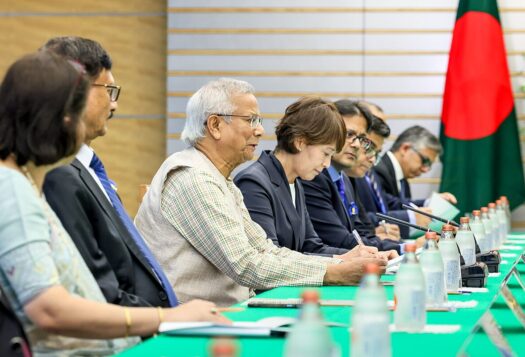
In the past few years, extreme weather conditions have become commonplace in Pakistan. Heat waves, droughts, and floods have become a yearly endemic, affecting food and water security. Marginalized communities—such as the poor, elderly, and women—face the brunt of these consequences. Despite being one of the world’s lowest carbon emitters, Pakistan is among the top ten nations most vulnerable to extreme climate events.
According to UNESCAP, Pakistan could lose more than 9 percent of its annual GDP due to climate change. Severe heat waves and untimely rains have also severely impacted Pakistan’s agricultural production. The Intergovernmental Panel on Climate Change has warned that the frequency of such extreme weather conditions will increase in the future, causing a severe risk to Pakistan’s food security. The Asian Development Bank projects sharp declines in key food and cash crops (such as wheat, sugar cane, rice, maize, and cotton) in the coming years due to rising cultivating costs and climate change.
Pakistan ranked 92nd out of 116 countries on the Global Hunger Index in 2021. Climate change and supply chain disruptions after Russia’s invasion of Ukraine are also likely to further aggravate the situation in the coming years. If timely measures are not taken to address food insecurity and adapt to the adverse effects of climate change, Pakistan can face an existential threat.
Extreme Climate Events Continue Unabated
Climate change is a direct threat to Pakistan’s food production. Himalayan glaciers, which feed the country’s primary water source (the Indus Basin), have lost more mass since 2000 than in the entire twentieth century. For a country like Pakistan, where 23 percent of its GDP relies on the agriculture sector and the Indus Basin, this is a serious cause for concern.
Beyond the risks of water shortages, extreme climate events are increasingly posing threats to livelihoods and agriculture. Each summer, heavy monsoon rainfall cause flash floods, property damage, and loss of life across the fertile plains of Punjab and Sindh. The consequences seem to worsen every year. This summer, historically high temperatures reached 51 degrees Celsius (approximately 123 degrees Fahrenheit) in Jacobabad, the highest temperature reported in South Asia. As the war in Ukraine halted wheat exports from “Europe’s breadbasket”, farmers in India estimated that the rise in temperature had destroyed 10-15 percent of their crops. With climate shocks like this expected to become only more frequent in the years ahead, Pakistan’s food production capacity may be hindered by extreme climate events.
The ongoing Russia-Ukraine war has also increased food insecurity—39 percent of Pakistan’s wheat imports come from Ukraine, which remains the fifth largest wheat exporter globally.
Pakistan’s total wheat demand—the primary source of fiber in the national diet and an important determinant of overall food security—is roughly 30.8 million tons. Heat waves in mid-March and increasing fertilizer costs led to an almost two million ton shortfall against a target of 28.9 million tons for this season. Supply and demand gaps are fulfilled by wheat imports in a volatile international market. This is a serious cause of concern for a country whose 40 percent of its population faces chronic food insecurity.
The ongoing Russia-Ukraine war has also increased food insecurity—39 percent of Pakistan’s wheat imports come from Ukraine, which remains the fifth largest wheat exporter globally. Russian blockades around the black sea have hampered Ukrainian wheat exports and global supply chains. This has impacted grain prices in the international market, with wheat flour prices increasing more than 60 percent since the onset of the war. Exports have recently resumed after being frozen for months which will lessen the risks of a global food crisis—still, continued volatility and longer-term climate strain threaten Pakistan’s food security.

To meet its domestic wheat demand, Pakistan would have to import approximately three million tons (considering the one million tons of wheat in stock from last year) at an expected cost of $1.5 billion. This will put further pressure on the country’s scarce foreign reserves, especially considering the recent depreciation of the rupee against the dollar. Historically, the government subsidizes wheat prices. If this trend continues, the government’s expenditure will rise amidst ongoing economic woes, leading to a further increase in the fiscal and current account deficit.
Food security will not solely be mitigated by adequate supply. In July, Pakistan’s consumer price inflation reached 24.9 percent, significantly limiting the purchasing power of the masses. Rising fuel prices have impacted the agriculture sector by increasing the cost of inputs, energy, and transportation. The cost of fertilizers and locally assembled tractors has sharply risen, making it difficult for farmers to afford them.
Pakistan is already facing an economic crisis with high levels of poverty, inflation, and limited access to basic services. Political instability, climate change, and food insecurity will further aggravate the country’s pre-existing problems. As livelihoods are impacted by climate change, internal migration and the displacement of thousands of people may lead to a resource-based conflict. The devastating floods of 2010 forced large number of farmers to migrate to cities in search of work. Climate-induced health risks may also increase in the coming years, putting pressure on the country’s limited health infrastructure. The severe heat waves in Karachi have caused an outbreak of malaria, dengue and gastroenteritis. The government needs to take climate change as a serious threat to the country already mired in socio-economic problems.
Pakistan is already facing an economic crisis with high levels of poverty, inflation, and limited access to basic services. Political instability, climate change, and food insecurity will further aggravate the country’s pre-existing problems.
In 2018, Pakistan introduced its first-ever National Food Security Policy, striving to increase food availability, accessibility, and sustainability by making the agriculture sector more productive, profitable, climate resilient, and competitive. While Pakistan has developed a comprehensive policy framework to address climate change and food insecurity at the national level, many policies suffer implementation gaps due to a lack of funding at the provincial level. Considering the current situation, there’s a substantial need for a transformation in Pakistan’s climate change adaption policies and food system.
What measures can Pakistan take to adapt to climate change?
Pakistan can invest in sustainable agriculture development practices and projects to adapt to the new realities of climate change. This could include moving towards climate-smart agricultural practices, such as switching to high-yielding crops, efficient water management, reducing water losses, and building small and medium size dams to tackle water shortages and boost agricultural output.
Farmers often rely on flood irrigation to grow crops like sugar-cane and rice. These crops consume excessive amounts of water and drain underground aquifers. This significantly reduces the water table and causes salinity and water logging, making land uncultivable for the next cropping season. The government should encourage the use of digital technologies, modern farming techniques, efficient farm mechanization and crop diversification through subsidies.
Minimizing carbon emissions will reduce the consequences of global warming in Pakistan. The government needs to introduce mass transit in all big cities and encourage consumers to switch to electric cars. This will also help in reducing the soaring oil import bill and give some relief to the masses from inflation caused by rising oil prices. The government can incentivize solar power by providing subsidies on consumer solar equipment, which will help offset the excessive load on the power supply.
Climate change, however, cannot be tackled by the government alone hence it needs community support. Pakistanis should be made better aware of the adverse effects of climate change and the importance of water conservation. Community-led sustainable development projects should be designed and implemented in order to better address the needs and concerns of marginalized communities – poor, women, disabled and indigenous groups. Pakistan needs to consider building an economy that is more sustainable, inclusive, and resilient against climate change.
***
Click here to read this article in Urdu.
Image 1: Uzair9 via Wikimedia Commons
Image 2: Rao Mubasher via Wikimedia Commons


